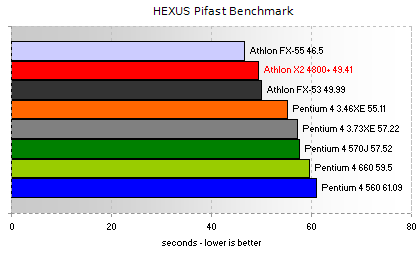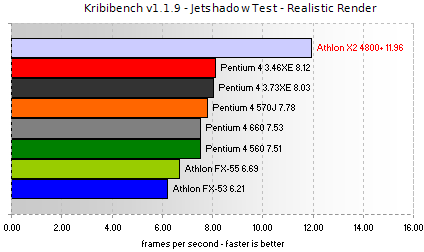Cinebench 2003, picCOLOR, Pifast, Realstorm, Kribibench
Cinebench 2003
We use the single-threaded component of Cinebench's CPU tests, to measure basic CPU performance. I'll use the multi-threaded version shortly.
The new core allows it slightly faster performance than the equivalently-clocked FX-53. It trails the FX-55 and bests all the other processors in this stern test of processor ability (both integer and floating point calculations are performed).
picCOLOR v4.0
picCOLOR v4.0 is multi-threaded in places (discussion of which deserves a separate article!), allowing any multi-processor system to exhibit better performance than an equivalent single-processor system.
The X2 is well ahead of everything else on test, its multiple cores allowing for higher performance than any single-core processor. Interestingly, testing the X2 on a different platform shows even higher scores (5.60).
HEXUS Pifast
Our Pifast test works the FPU of a processor hard, along with the memory controller.
The X2 is slightly ahead of the FX-53, with which it shares external clock frequency and L2 cache size. The new core revision used to build an X2 is, on the whole, ever so slightly quicker than older revision AMD64 CPUs.
Realstorm 2004
Realstorm is a single-threaded real-time raytracer, which draws a 3D scene using nothing but the host processor.
In this test, the X2 is slightly slower than both FX-53 and FX-55. It managed to outpace all the Pentium 4 processors without any problem, a testament to the strong FPU on AMD's processors.
Kribibench
Kribi is multi-threaded, stressing the floating point unit on a processor as much as it can.
Two heads are better than one, as they say. Lots-o-cores equals lots-o-performance. Now for a look at a few of our professional-level tests.









